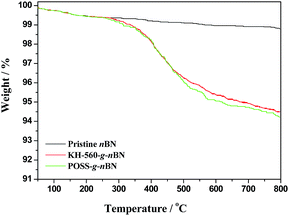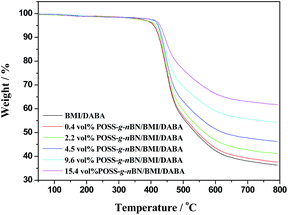Ideal dielectric thermally conductive bismaleimide nanocomposites filled with polyhedral oligomeric silsesquioxane functionalized nanosized boron nitride
Junwei Gu*,
Chaobo Liang,
Jing Dang,
Wencai Dong and
Qiuyu Zhang*
Key Laboratory of Space Applied Physics and Chemistry, Ministry of Education, Department of Applied Chemistry, School of Science, Northwestern Polytechnical University, Xi’an, Shaanxi 710072, P. R. China. E-mail: gjw@nwpu.edu.cn; qyzhang1803@gmail.com; Fax: +86-29-88431621; Tel: +86-29-88431621
First published on 31st March 2016
Abstract
Silane coupling reagent γ-glycidoxy propyl trimethoxy silane/polyhedral oligomeric silsesquioxane (KH-560/POSS) functionalized nanosized boron nitride (POSS-g-nBN) fillers were performed to fabricate thermally conductive bismaleimide/diallylbisphenol A (BMI/DABA) nanocomposites combining excellent dielectric properties and outstanding thermal stability. POSS molecules have been grafted on the surface of the nBN fillers. The POSS-g-nBN/BMI/DABA nanocomposite with 15.4 vol% POSS-g-nBN is an excellent dielectric composite material with high thermal conductivity and outstanding thermal stability; the corresponding dielectric constant ε is 3.42, the dielectric loss factor tan![[thin space (1/6-em)]](https://www.rsc.org/images/entities/char_2009.gif) δ is 0.0085, the thermally conductive coefficient λ is 0.607 W m−1 K−1 (increased by 266% compared to that of pure BMI/DABA), and the 5 wt% thermal weight loss temperature (T5) reaches up to 428 °C, which holds potential for use in the integration and the miniaturization of microelectronic devices.
δ is 0.0085, the thermally conductive coefficient λ is 0.607 W m−1 K−1 (increased by 266% compared to that of pure BMI/DABA), and the 5 wt% thermal weight loss temperature (T5) reaches up to 428 °C, which holds potential for use in the integration and the miniaturization of microelectronic devices.
Introduction
Bismaleimide (BMI) resins possess excellent dielectric properties, outstanding thermal stabilities, excellent mechanical properties, good humidity & corrosion resistance and an attractive cost/performance ratio, and have been widely applied in the fields of electronics, insulation, adhesives and other key areas.1–6However, the main disadvantages of BMI matrices, such as inherent brittleness,7 poor processing characteristics, low thermal conductivity,8,9 etc., have limited their broader application, especially in the fields of electronic and micromechanical devices which need materials with excellent dielectric properties, high thermal conductivities and outstanding thermal stabilities.10–12
At present, many methods have been proposed to improve the toughness of the BMI matrix, but the corresponding thermal resistance and dielectric properties are often decreased inevitably.13 To our knowledge, a two-component resin system based on a BMI matrix and diallylbisphenol A (DABA) has presented good processing characteristics, excellent dielectric properties and improved toughness.14
The addition of thermally conductive fillers into the polymeric matrix can be regarded as one of the most economical and effective ways to improve the thermal conductivity of polymers.15–21 Nanosized boron nitride (nBN) possesses excellent dielectric properties, high thermal conductivity and outstanding thermal stability, and has been widely used in the preparation of polymeric composites with high thermal conductivity.22 However, the interfacial thermal barrier between pristine nBN fillers and the BMI matrix may hinder heat transport, against the improvement of the thermal conductivity. In our previous work, the interfacial thermal barrier between BN fillers and epoxy resins was effectively decreased through the surface functionalization of BN fillers.23
Polyhedral oligomeric silsesquioxanes (POSS) molecules present a fairly low dielectric constant ε and relatively excellent thermal stability.24,25 Furthermore, POSS molecules can also be easily introduced into a polymeric system via blending, grafting and/or copolymerization.26,27 Therefore, capitalizing on the POSS molecule and nBN fillers can be promising to fabricate ideal dielectric thermally conductive BMI nanocomposites with outstanding thermal stabilities.
In our present work, nanosized boron nitride (nBN) fillers and diallylbisphenol A (DABA) were synchronously introduced into the N,N′-4,4′-bismaleimide diphenylmethane (BMI) matrix to fabricate nBN/BMI/DABA nanocomposites through a casting molding method, herein, with BMI as a polymeric matrix, DABA as a toughening agent and nBN as thermally conductive fillers. The combination method of γ-glycidoxy propyl trimethoxy silane/polyhedral oligomeric silsesquioxane (KH-560/POSS) was proposed to functionalize the surface of the nBN fillers (POSS-g-nBN), to further optimize the dielectric properties, thermal conductivities and mechanical properties of the BMI/DABA nanocomposites. The surface performance of pristine nBN and POSS-g-nBN was analyzed and characterized using X-ray photoelectron spectroscopy (XPS), Fourier transform infrared (FTIR) spectroscopy and thermogravimetric analysis (TGA). Also the effect of the volume fraction of nBN & POSS-g-nBN on the dielectric properties, thermal conductivities, thermal stabilities and mechanical properties of the BMI/DABA nanocomposites was also discussed and investigated.
Experimental
Materials
N,N′-4,4′-Bismaleimide diphenylmethane (BMI) was purchased from Hubei Fenghua Chemical Factory (Hubei, China); diallylbisphenol A (DABA) was supplied from Qinyang Tianyi Chemical Industrial Co. Ltd. (Henan, China); nanosized boron nitride (nBN), with a diameter of 80–120 nm, was received from Xuzhou Hongwu Nanomaterial Co., Ltd (Jiangsu, China); aminopropylisobutyl polyhedral oligomeric silsesquioxane, AM0265 (POSS), was purchased from Hybrid Plastics Corp. (Hattiesburg, USA); the silane coupling reagent of γ-glycidoxy propyl trimethoxy silane (KH-560) was supplied by Nanjing Shuguang Chemical Group Co., Ltd (Jiangsu, China).Surface functionalization of nBN fillers
A mixture of nBN/KH-560/ethanol/water (20/1/250/250, wt/wt/wt/wt) was firstly mixed and reacted in the reaction kettle for 6 h at 70 °C (pH = 8.5) with stirring, then dried under vacuum at 100 °C for 24 h, to obtain KH-560 grafted nBN (KH-560-g-nBN). And then a mixture of KH-560-g-nBN/POSS/THF (20/1/200, wt/wt/wt) was stirred magnetically and reacted for another 4 h at 60 °C, then washed using distilled water, and finally dried at 100 °C for another 24 h, to obtain POSS grafted nBN (POSS-g-nBN). Fig. 1 shows the general fabrication process of KH-560/POSS functionalized nBN (POSS-g-nBN). | ||
| Fig. 1 Schematic diagram of the general fabrication process of KH-560/POSS functionalized nBN (POSS-g-nBN). | ||
Preparation of the POSS-g-nBN/BMI nanocomposites
The BMI matrix and DABA (2/1, mol/mol) were mixed well in an oil-bath at 50 °C, then the mixture of BMI/DABA above was heated up to 140 °C and reacted for 40 minutes, to obtain the corresponding BMI/DABA prepolymers. The right amount of POSS-g-nBN was then added to the BMI/DABA prepolymers and stirred evenly. The obtained POSS-g-nBN/BMI/DABA mixture was degassed in a vacuum oven at 140 °C for 2 h to eliminate the entrapped air, then was poured into a preheated glass mold. Finally the POSS-g-nBN/BMI/DABA mixture was cured according to the following guidelines: 150 °C/2 h + 170 °C/1 h + 190 °C/2 h + 210 °C/2 h, followed by post-curing at 240 °C for 4 h.Analysis and characterization
X-ray photoelectron spectroscopy (XPS) analysis of the samples was carried out using PHI5400 equipment (PE Corp., England); Fourier transform infrared (FTIR) spectra were obtained on Bruker Tensor 27 equipment (Bruker Corp., Germany); thermal gravimetric (TG) analysis of the samples was carried out at 10 °C min−1 (argon atmosphere) over a whole range of temperatures (40–800 °C) using an STA 449F3 (NETZSCH C Corp., Germany); the dielectric constant (ε) and dielectric loss factor (tan![[thin space (1/6-em)]](https://www.rsc.org/images/entities/char_2009.gif) δ) values of the samples were measured using the high frequency Q instrument QBG-3D and the dielectric constant detector S914 (Shanghai Aiyi Electronic Equipment Co. Ltd., China); thermally conductive coefficient λ values of the samples were measured using a TPS2200 Hot Disk instrument (AB Corporation, Sweden), according to the standard ISO 22007-2: 2008; the flexural strength of the samples was measured using an Electron Omnipotence Experiment Machine SANS-CMT5105 (Shenzhen New Sansi Corp., China) according to the standard ISO 178-1993; and the impact strength of the samples was measured with a ZBC-4B impact testing machine (Shenzhen New Sansi Corp., China) according to the standard ISO 179-1993.
δ) values of the samples were measured using the high frequency Q instrument QBG-3D and the dielectric constant detector S914 (Shanghai Aiyi Electronic Equipment Co. Ltd., China); thermally conductive coefficient λ values of the samples were measured using a TPS2200 Hot Disk instrument (AB Corporation, Sweden), according to the standard ISO 22007-2: 2008; the flexural strength of the samples was measured using an Electron Omnipotence Experiment Machine SANS-CMT5105 (Shenzhen New Sansi Corp., China) according to the standard ISO 178-1993; and the impact strength of the samples was measured with a ZBC-4B impact testing machine (Shenzhen New Sansi Corp., China) according to the standard ISO 179-1993.
Results and discussion
Surface functionalization of nBN fillers
Fig. 2 shows the XPS scanning spectra of pristine nBN and functionalized nBN. There are carbon (C), oxygen (O), boron (B) and nitrogen (N) elements on the surface of the pristine nBN. After surface functionalization, the corresponding peaks of O1s and C1s are both increased, but the N1s peak is decreased. This is due to the contribution of the KH-560 and POSS molecules on the surface of nBN. Compared with KH-560-g-nBN, POSS-g-nBN presents relatively stronger peaks of Si2s and Si2p.FTIR spectra of pristine nBN and functionalized nBN are shown in Fig. 3. The strong bands at 1380 cm−1 and 800 cm−1 can be assigned to the characteristic absorption peaks of B–N. After surface functionalization, a new characteristic vibration absorption peak for Si–O appears near 1050 cm−1, owing to the introduction of KH-560 and POSS molecules. Compared with KH-560-g-nBN, POSS-g-nBN presents a relatively broader absorption peak of Si–O.
Fig. 4 shows TGA curves of pristine nBN and functionalized nBN. The weight loss value of pristine nBN is about 1.2 percent in the range of 40–800 °C, mostly due to the loss of absorbed water molecules on the surface of nBN. After surface functionalization, the corresponding weight loss values for KH-560-g-nBN and POSS-g-nBN are both increased obviously over 300 °C, which is ascribed to the oxidation or thermal cracking of KH-560 and POSS molecules at higher temperatures. And the corresponding weight loss values of KH-560-g-nBN and POSS-g-nBN up to 800 °C are about 5.5 percent and 5.8 percent, respectively.
Dielectric properties of the BMI/DABA nanocomposites
Fig. 5 shows the effect of the volume fraction of nBN and POSS-g-nBN on the dielectric properties of the BMI/DABA nanocomposites. With the increasing addition of nBN, the ε values of the BMI/DABA nanocomposites are improved. However, the corresponding tan![[thin space (1/6-em)]](https://www.rsc.org/images/entities/char_2009.gif) δ values are decreased. For a given nBN loading, the surface functionalization of nBN can further decrease the ε and tan
δ values are decreased. For a given nBN loading, the surface functionalization of nBN can further decrease the ε and tan![[thin space (1/6-em)]](https://www.rsc.org/images/entities/char_2009.gif) δ values of the BMI nanocomposites. The corresponding ε and tan
δ values of the BMI nanocomposites. The corresponding ε and tan![[thin space (1/6-em)]](https://www.rsc.org/images/entities/char_2009.gif) δ values of the POSS-g-nBN/BMI/DABA nanocomposite with 15.4 vol% POSS-g-nBN are 3.42 and 0.0085, respectively.
δ values of the POSS-g-nBN/BMI/DABA nanocomposite with 15.4 vol% POSS-g-nBN are 3.42 and 0.0085, respectively.
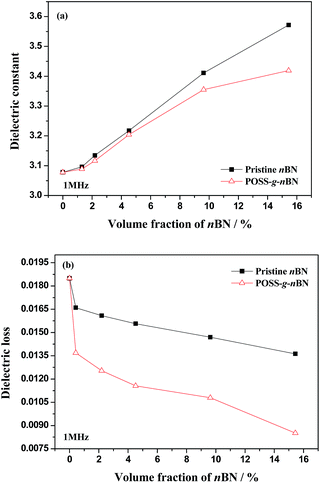 | ||
| Fig. 5 Effect of the volume fraction of nBN and POSS-g-nBN on the dielectric properties of the BMI/DABA nanocomposites. | ||
nBN possesses a relatively higher ε value than that of pure BMI/DABA. With the increasing addition of nBN, nBN can touch, and continuous channels of nBN–nBN are formed through tunneling effects & electron transitions, resulting in the improvement of the polarization performance for the BMI/DABA nanocomposites. Therefore, the corresponding ε values of the BMI/DABA nanocomposites are increased. However, the introduction of nBN with a low tan![[thin space (1/6-em)]](https://www.rsc.org/images/entities/char_2009.gif) δ value can counteract the improvement in the polarization performance of the BMI/DABA nanocomposites, which leads to a reduction in the tan
δ value can counteract the improvement in the polarization performance of the BMI/DABA nanocomposites, which leads to a reduction in the tan![[thin space (1/6-em)]](https://www.rsc.org/images/entities/char_2009.gif) δ value.
δ value.
Additionally, the introduction of POSS-g-nBN can further decrease the ε and tan![[thin space (1/6-em)]](https://www.rsc.org/images/entities/char_2009.gif) δ values of the BMI/DABA nanocomposites. On one side, POSS molecules have a relatively lower ε value; on the other side, the interfacial compatibility between the POSS-g-nBN fillers and BMI/DABA is further increased, resulting in the decrease in the interfacial defects, finally to further decrease the ε and tan
δ values of the BMI/DABA nanocomposites. On one side, POSS molecules have a relatively lower ε value; on the other side, the interfacial compatibility between the POSS-g-nBN fillers and BMI/DABA is further increased, resulting in the decrease in the interfacial defects, finally to further decrease the ε and tan![[thin space (1/6-em)]](https://www.rsc.org/images/entities/char_2009.gif) δ values of the BMI/DABA nanocomposites.
δ values of the BMI/DABA nanocomposites.
Thermal conductivities of the BMI/DABA nanocomposites
The effect of the volume fraction of nBN and POSS-g-nBN on the thermal conductivities of the BMI/DABA nanocomposites is shown in Fig. 6. The thermal conductivities of the BMI/DABA nanocomposites increase with the increasing addition of nBN. For a given nBN loading, the surface functionalization of nBN can further improve the thermal conductivities of the BMI/DABA nanocomposites. The thermal conductivity coefficient λ of the POSS-g-nBN/BMI/DABA nanocomposite with 15.4 vol% POSS-g-nBN is 0.607 W m−1 K−1, an increase of 266% compared to that of pure BMI/DABA (0.228 W m−1 K−1).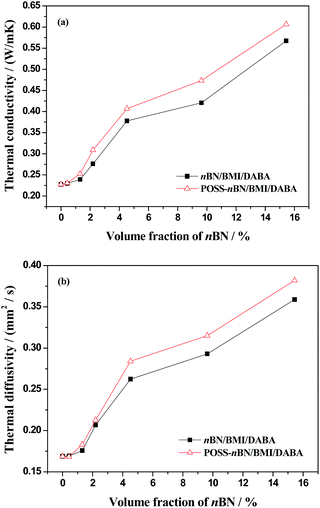 | ||
| Fig. 6 Effect of the volume fraction of nBN and POSS-g-nBN on the thermal conductivities of the BMI/DABA nanocomposites. | ||
The addition of low volume fractions of nBN leads to little interaction between nBN. With the increasing addition of nBN, effective thermally conductive channels & networks are formed easily, due to the connections of nBN to nBN. Thus the corresponding thermal conductivities of the BMI nanocomposites are increased.
For a given nBN loading, surface functionalization of nBN can further improve the uniform dispersion of POSS-g-nBN in the BMI/DABA, in favor of increasing the formation probability of thermally conductive channels & networks of POSS-g-nBN. Moreover, POSS-g-nBN also presents relatively better interfacial compatibility with BMI/DABA, which can effectively decrease the interfacial thermal barrier between POSS-g-nBN fillers and BMI/DABA. And the thermal conductivities of the BMI nanocomposites are further increased accordingly.
Meanwhile, experimentally determined thermal conductivity coefficient λ values and theoretically predicted values from series conduction, parallel conduction, Maxwell–Eucken and Effective Medium Theory (EMT) models are shown in Fig. 7.21,28–30
 | ||
| Fig. 7 Thermal conductivities’ comparison between experimental and theory predicted values for POSS-g-nBN/BMI/DABA nanocomposites. | ||
The experimental thermal conductivity coefficient λ values of the POSS-g-nBN/BMI/DABA nanocomposites are much smaller than the theoretically predicted values from the parallel conduction, upper bound of Maxwell–Eucken and EMT models, and the experimental values are slightly more than those predicted by the series conduction and lower bound of Maxwell–Eucken models. The reason is that thermally conductive channels & networks of POSS-g-nBN can be formed with an increasing volume fraction of POSS-g-nBN. However, voids or defects are also easily introduced into the BMI nanocomposites with the excessive addition of POSS-g-nBN. All the model equations mentioned have certain limitations and errors in predicting the corresponding thermal conductivity coefficient λ values of the POSS-g-nBN/BMI/DABA nanocomposites, and remain to be further modified and improved.21
Mechanical properties of the BMI/DABA nanocomposites
The effect of the volume fraction of nBN and POSS-g-nBN on the mechanical properties of the BMI/DABA nanocomposites are shown in Fig. 8. Both the flexural strength and impact strength of the BMI/DABA nanocomposites increase up to a 0.4 vol% incorporation, but decrease with the further addition of nBN. The mechanical properties of the BMI/DABA nanocomposites are found to be optimal at 0.4 vol% POSS-g-nBN. Compared with pure BMI/DABA (flexural strength of 123.8 MPa and impact strength of 12.4 kJ m−2), the maximum flexural and impact strengths of the BMI/DABA nanocomposite with 0.4 vol% POSS-g-nBN are improved to 141.7 MPa and 14.8 kJ m−2, an increase of 14.5% and 19.4%, respectively. The reason is that appropriate amounts of nBN can effectively prevent the appearance of destructive cracks. However, with the excessive addition of nBN, more interfacial defects and stress concentration points are easily introduced into the BMI/DABA system, which leads to a reduction in the mechanical properties of the BMI/DABA nanocomposites.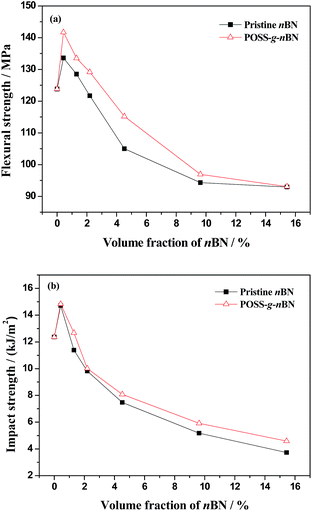 | ||
| Fig. 8 Effect of the volume fraction of nBN and POSS-g-nBN on the mechanical properties of the BMI/DABA nanocomposites. | ||
For a given nBN loading, surface functionalization of nBN can further improve the interfacial compatibility between POSS-g-nBN fillers and BMI/DABA, resulting in a decrease in the inner defects (Fig. 9). Furthermore, the amino group (–NH2) on the surface of POSS-g-nBN can also react with the unsaturated double bonds in the BMI matrix, to enhance further the interface bonding strength between POSS-g-nBN fillers and BMI/DABA. With the two parts working together, the mechanical properties of the BMI/DABA nanocomposites are further improved effectively.
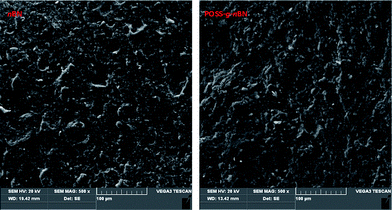 | ||
| Fig. 9 SEM morphologies of impact fractures for the BMI/DABA nanocomposites filled with a 9.6 vol% addition of pristine nBN (a) and POSS-g-nBN (b). | ||
Thermal properties of the BMI/DABA nanocomposites
TGA curves for pure BMI/DABA and POSS-g-nBN/BMI/DABA nanocomposites are presented in Fig. 10 and the corresponding characteristic thermal data are listed in Table 1. For the same degree of weight loss, the corresponding thermal decomposition temperatures of the BMI/DABA nanocomposites increase with the increasing addition of POSS-g-nBN. The corresponding Theat-resisting index is 214.3 °C (pure BMI/DABA), 214.8 °C (0.4 vol% POSS-g-nBN), 217.1 °C (2.2 vol% POSS-g-nBN), 220.4 °C (4.5 vol% POSS-g-nBN), 228.7 °C (9.6 vol% POSS-g-nBN) and 247.4 °C (15.4 vol% POSS-g-nBN). This reveals that the thermal stabilities of the POSS-g-nBN/BMI/DABA nanocomposites increase with the increasing addition of POSS-g-nBN. The reason is that, compared to pure BMI/DABA, POSS-g-nBN has more excellent thermal conductivity. Meanwhile, the better interfacial compatibility between the POSS-g-nBN fillers and BMI/DABA can represent a better blending effect between POSS-g-nBN fillers and BMI/DABA, which can also enhance the thermal stabilities of the BMI nanocomposites. Furthermore, the amino group (–NH2) on the surface of POSS-g-nBN can also react with the unsaturated double bonds in the BMI matrix, resulting in the improvement in the thermal stabilities.| Samples | Temperatures for weight loss/°C | Theat-resistance indexa/°C | |
|---|---|---|---|
| 5 wt% | 30 wt% | ||
| a Theat-resistance index = 0.49 × [T5 + 0.6 × (T30 − T5)]17 where T5 and T30 is the corresponding decomposition temperature for 5% and 30% weight loss, respectively. | |||
| BMI/DABA | 408 | 457 | 214.3 |
| 0.4 vol% POSS-g-nBN/BMI/DABA | 409 | 458 | 214.8 |
| 2.2 vol% POSS-g-nBN/BMI/DABA | 415 | 462 | 217.1 |
| 4.5 vol% POSS-g-nBN/BMI/DABA | 421 | 469 | 220.4 |
| 9.6 vol% POSS-g-nBN/BMI/DABA | 423 | 496 | 228.7 |
| 15.4 vol% POSS-g-nBN/BMI/DABA | 428 | 556 | 247.4 |
Conclusions
XPS, FTIR and TG analyses reveal that NH2–POSS molecules have been successfully grafted on the surface of nBN. The introduction of POSS-g-nBN can further optimize the dielectric properties, and also further improve the thermal conductivities & mechanical properties of the BMI/DABA nanocomposites.The POSS-g-nBN/BMI/DABA nanocomposite with 15.4 vol% POSS-g-nBN is an ideal dielectric composite material with high thermal conductivity and outstanding thermal stability, the corresponding dielectric constant ε is 3.42, the dielectric loss factor tan![[thin space (1/6-em)]](https://www.rsc.org/images/entities/char_2009.gif) δ is 0.0085, the thermal conductivity coefficient λ is 0.607 W m−1 K−1 (an increase of 266% compared to pure BMI/DABA), and the 5 wt% thermal weight loss temperature (T5) reaches up to 428 °C, which holds potential for use in the integration and miniaturization of microelectronic devices.
δ is 0.0085, the thermal conductivity coefficient λ is 0.607 W m−1 K−1 (an increase of 266% compared to pure BMI/DABA), and the 5 wt% thermal weight loss temperature (T5) reaches up to 428 °C, which holds potential for use in the integration and miniaturization of microelectronic devices.
Acknowledgements
The authors are grateful for support and funding from the Foundation of National Natural Science Foundation of China (No. 51403175); Shaanxi Natural Science Foundation of Shaanxi Province (No. 2015JM5153); the Fund of Aeronautics Science (No. 2015ZF53074); the Open Fund from National Defense Science and Technology Key Laboratory (No. 2015AFDL018); the Fundamental Research Funds for the Central Universities (No. 3102015ZY066 and 3102015BJ(II)JGZ020) and Undergraduate Innovation Program (No. 201510699240).References
- G. Z. Liang and A. J. Gu, Bismaleimide, 1997, 1–5 CAS.
- X. Wang, Q. Jiang, W. Z. Xu, W. Cai, Y. Inoue and Y. T. Zhu, Carbon, 2013, 53, 145–152 CrossRef CAS.
- L. N. Liu, A. J. Gu, Z. P. Fang, L. F. Tong and Z. B. Xu, Composites, Part A, 2007, 38, 1957–1964 CrossRef.
- D. K. Chakravarthi, V. N. Khabashesku, R. Vaidyanathan, J. Blaine, S. Yarlagadda, D. Roseman, Q. Zeng and E. V. Barrera, Adv. Funct. Mater., 2011, 21, 2527–2533 CrossRef CAS.
- M. Neda, K. Okinaga and M. Shibata, Mater. Des., 2014, 53, 466–474 CrossRef.
- Y. N. Liu, M. Li, Y. Z. Gu, Y. Y. Zhang, Q. W. Li and Z. G. Zhang, Compos. Sci. Technol., 2015, 117, 176–182 CrossRef CAS.
- M. Mandhakini, A. Chandramohan, K. Jayanthi and M. Alagar, Mater. Des., 2014, 64, 706–713 CrossRef CAS.
- Y. J. Zhu, L. Yuan, G. Z. Liang and A. J. Gu, Polym. Degrad. Stab., 2015, 118, 33–44 CrossRef CAS.
- J. Dang, R. M. Wang, L. Yang, L. H. Gao, Z. Zhang and M. Zha, Polym. Compos., 2014, 35, 1875–1878 CrossRef CAS.
- X. Y. Huang, C. Y. Zhi, P. K. Jiang, D. Golberg, Y. Bando and T. Tanaka, Adv. Funct. Mater., 2013, 23, 1824–1831 CrossRef CAS.
- K. M. F. Shahil and A. A. Balandin, Nano Lett., 2012, 12, 861–867 CrossRef CAS PubMed.
- J. W. Gu, Y. Q. Guo, Z. Y. Lv, W. C. Geng and Q. Y. Zhang, Composites, Part A, 2015, 78, 95–101 CrossRef CAS.
- Q. F. Cheng, J. W. Bao, J. Y. Park, Z. Y. Liang, C. Zhang and B. Wang, Adv. Funct. Mater., 2009, 19, 3219–3225 CrossRef CAS.
- J. Dang, R. M. Wang, R. X. Lou, Z. Zhang and W. J. Qi, Polym. Bull., 2014, 71, 787–794 CrossRef CAS.
- J. W. Gu, X. T. Yang, Z. Y. Lv, N. Li, C. B. Liang and Q. Y. Zhang, Int. J. Heat Mass Transfer, 2016, 92, 15–22 CrossRef CAS.
- P. Ding, J. Zhang, N. Song, S. F. Tang, Y. M. Liu and L. Y. Shi, Composites, Part A, 2015, 69, 186–194 CrossRef CAS.
- J. W. Gu, Z. Y. Lv, Y. L. Wu, R. X. Zhao, L. D. Tian and Q. Y. Zhang, Composites Part A, 2015, 79, 8–13 CrossRef CAS.
- P. Ding, J. Zhang, N. Song, S. F Tang, Y. M. Liu and L. Y. Shi, Compos. Sci. Technol., 2015, 109, 25–31 CrossRef CAS.
- J. W. Gu, Q. Y. Zhang, Y. S. Tang, J. P. Zhang, J. Kong, J. Dang, H. P. Zhang and X. Q. Wang, Surf. Coat. Technol., 2008, 202, 2891–2896 CrossRef CAS.
- W. Y. Zhou, Q. G. Chen, X. Z. Sui, L. N. Dong and Z. J. Wang, Composites Part A, 2015, 71, 184–191 CrossRef CAS.
- J. W. Gu, N. Li, L. D. Tian, Z. Y. Lv and Q. Y. Zhang, RSC Adv., 2015, 5, 36334–36339 RSC.
- S. Takahashi, Y. Imai, A. Kan, Y. Hotta and H. Ogawa, J. Alloys Compd., 2014, 615, 141–145 CrossRef CAS.
- J. W. Gu, Q. Y. Zhang, J. Dang and C. Xie, Polym. Adv. Technol., 2012, 23, 1025–1028 CrossRef CAS.
- I. Blanco, L. Abate, F. A. Bottino, P. Bottino and M. A. Chiacchio, J. Therm. Anal. Calorim., 2011, 107, 1083–1091 CrossRef.
- I. Blanco, L. Abate and F. A. Bottino, J. Therm. Anal. Calorim., 2014, 116, 5–13 CrossRef CAS.
- Z. H. Zhang, L. Z. Hong, Y. Gao and W. A. Zhang, Polym. Chem., 2014, 5, 4534–4541 RSC.
- V. Pistor, B. G. Soares and R. S. Mauler, Polymer, 2013, 54, 2292–2298 CrossRef CAS.
- Y. Agari, A. Ueda and S. Nagai, J. Appl. Polym. Sci., 1993, 49, 1625–1634 CrossRef CAS.
- T. Lewis and L. Nielsen, J. Appl. Polym. Sci., 1970, 14, 1449–1471 CrossRef CAS.
- J. K. Carson, S. J. Lovatt, D. J. Tanner and A. C. Cleland, Int. J. Heat Mass Transfer, 2005, 48, 2150–2158 CrossRef.
| This journal is © The Royal Society of Chemistry 2016 |



